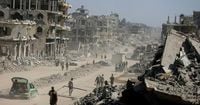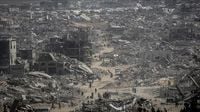On Thursday, October 16, 2025, Palestinian Prime Minister Mohammad Mustafa stood before an audience of diplomats, international institution representatives, and ministers in Ramallah, unveiling what he described as the most ambitious recovery and reconstruction plan ever conceived for the Gaza Strip. The price tag? A staggering $67 billion. The plan, developed in partnership with Arab and international experts, aims to heal the wounds of nearly two years of relentless conflict and devastation, promising to rebuild Gaza over five years through a meticulously structured, three-phase approach.
According to Anadolu Agency, the announcement was not just a local affair. About 100 representatives of international and UN institutions, members of the diplomatic corps accredited to the State of Palestine, and several relevant ministers gathered for the occasion, underscoring the global significance of the effort. Mustafa did not mince words about the scale of the challenge: "After more than two years of devastating war, the Gaza Strip has suffered widespread destruction, mass displacement, and profound human suffering, yet the Government of the State of Palestine remains steadfast in its determination to lead a fully Palestinian-owned national recovery and reconstruction process that restores dignity and hope to our steadfast people."
The plan, as detailed by Mustafa and reported by Xinhua, is rooted in the Arab Plan for Recovery, Reconstruction, and Development in Gaza, which was adopted at the Extraordinary Arab Summit in Cairo in March 2025. This framework has produced 56 subprograms across 18 sectors, ranging from housing and social services to infrastructure, economy, and governance. The sheer breadth of the initiative is daunting, but so is the destruction it seeks to remedy. Jaco Cilliers, the United Nations Development Program’s special representative for the Palestinian People, painted a vivid picture: the war left about 55 million tons of rubble—equivalent to 13 Giza pyramids—scattered across Gaza. Clearing this debris, along with safely disposing of approximately 20,000 unexploded explosive objects, is the immediate priority, Cilliers explained.
The recovery roadmap is divided into three distinct phases. The first, a six-month emergency phase, will cost $3.5 billion and focus on early recovery: removing rubble, rehabilitating basic infrastructure, providing temporary housing, and delivering cash assistance and "cash for work" programs. It will also support small projects and agriculture to revive livelihoods, reactivate the banking system, and provide psychological, educational, and health services—including specialized support for people with disabilities. However, none of this can begin until a ceasefire is firmly in place and necessary security and financial supplies are secured, Mustafa emphasized.
The second phase, spanning three years and requiring $30 billion, will focus on the reconstruction and revitalization of vital sectors. The final phase, described as the completion of comprehensive reconstruction, will extend over several years, with the goal of restoring a non-besieged, connected, and prosperous Gaza in line with United Nations resolutions and the New York Declaration.
To ensure transparency and accountability, the reconstruction process will be implemented through relevant Palestinian ministries and institutions, in close coordination with international partners. Mustafa was adamant that the process must be led by the Palestinian Authority, with international supervision where appropriate. "The main sectors such as health, education, water and sanitation, land and civil registry, public finance, taxes, and others are based on a unified system in the West Bank and Gaza Strip. These systems, which are recognized by international partners, must be enabled and strengthened, and not replaced by parallel or temporary structures that will not be able to maintain the provision of effective and real services on the ground," he stated.
As for the international community, Mustafa’s message was clear: support is crucial, but so is respect for Palestinian leadership. "The reconstruction of Gaza must be under Palestinian leadership, Arab support, and international backing, ensuring not only the reconstruction of Gaza, but also the restoration of hope, dignity, and stability for our people," he declared. There is also openness to temporary international or regional presence in Gaza, provided it is mandated by the UN Security Council, time-bound, and fully subject to Palestinian sovereignty and legitimate authority.
But the challenges go well beyond the technical. According to Anadolu Agency, Mustafa stressed that Israel must fulfill its obligations by withdrawing from Gaza, opening border crossings, and allowing the entry of humanitarian aid and reconstruction materials. Without these steps, the plan’s success remains in jeopardy. At the same time, the Palestinian vision remains anchored in unity: the reconstruction effort is designed to strengthen integration between Gaza and the West Bank, contributing to the restoration of a unified Palestinian governance framework.
The plan’s unveiling comes at a critical juncture. Earlier in the week, U.S. President Donald Trump signed a Gaza ceasefire agreement with the leaders of Qatar, Egypt, and Türkiye—a move hailed by some as a step toward lasting peace in the region. Whether this ceasefire will hold and provide the necessary political space for recovery remains to be seen.
Meanwhile, the humanitarian situation on the ground is dire. Doctors Without Borders, in a statement cited by IMEMC, reported no improvement in its ability to bring in aid, saying, "We need aid to arrive before talking about rebuilding hospitals in Gaza." The organization described the health sector as facing the largest construction and humanitarian disaster in modern history, with 70 million tons of rubble and thousands of unexploded munitions posing a daily threat to civilians and aid workers alike.
Looking ahead, a major reconstruction conference is scheduled to take place in Egypt—one month after the end of the war, according to Anadolu Agency, or in November as reported by Xinhua. This conference aims to serve as a central platform for mobilizing international resources, building partnerships, and creating a multilateral cooperation framework to advance Gaza’s rebuilding. Mustafa underscored its importance: "A reconstruction conference for the Gaza Strip will be held in the Republic of Egypt, and the conference will be a major platform for mobilizing resources and building partnerships."
All told, the recovery and reconstruction of Gaza stands as one of the largest and most complex humanitarian undertakings in recent memory. The numbers alone are staggering, but the human stakes are even higher. As Mustafa put it, the goal is not just to rebuild structures, but to restore hope, dignity, and stability to a people who have endured unimaginable suffering.
With the world’s eyes on Gaza, the coming months will reveal whether this ambitious blueprint can move from promise to reality, and whether the international community will step up to help turn devastation into renewal.

